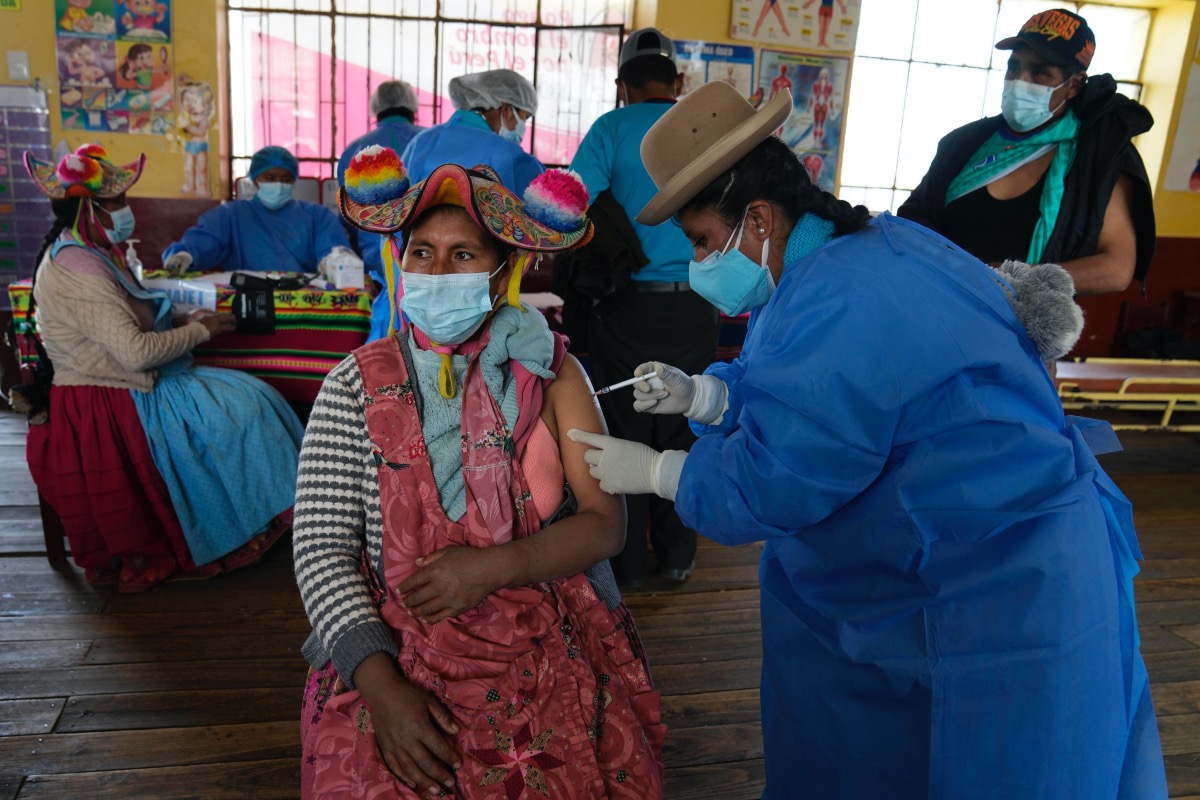

A health worker gives a shot of the Sinopharm vaccine for COVID-19 to Yolanda Coila, during a vaccine campaign in Jochi San Francisco, Peru, Friday, Oct. 29, 2021. While more than 55% of Peruvians have gotten at least one shot of COVID-19 vaccines, only about 25% of people in Indigenous areas have been vaccinated. (AP Photo/Martin Mejia)
By FRANKLIN BRICEÑO Associated Press
Maribel Vilca didn’t even bother to go to the community meeting that gave information to her Indigenous community about COVID-19 vaccines.
“What happens if I die with the vaccine? I have small children,” she said, expressing mistrust of the government health services after bad experiences during two pregnancies.
The fears expressed by the 38-year-old woman, who lives near the shore of Lake Titicaca, are common among Peru’s Indigenous people, who make up about a quarter of the country’s 33 million people —and they have complicated the national vaccination drive.
While more than 55 percent of Peruvians have gotten at least one shot of COVID-19 vaccines, only about 25 percent of people in Indigenous areas have been vaccinated.
Authorities say that’s partly due to the difficulty of getting vaccines to remote Andean and Amazon regions where many Indigenous people live and distributing them. Some clinics are so poorly funded they lack gasoline for their vehicles.
And some Indigenous representatives complain that, as in other countries around the region, the government has been slow to coordinate with Indigenous leaders on how best to reach those communities.
But it’s also true that ingrained distrust of government authorities has made people open to baseless rumors and conspiracy fantasies —spread by social media or word of mouth— about vaccines that could save many thousands of lives.
Despite overwhelming evidence based on more than seven billion vaccine doses delivered worldwide that serious side effects are very rare, Vilca said she fears a shot might kill or harm her.
Rumors about vaccines, sometimes spread on local Quechua-language community radio, often mimic QAnon-type misinformation spread across social media in the U.S. and Europe about tracking microchips or terrible side effects.
And for Peru’s Indigenous people, both ancient and recent history gives reason for mistrust.
Many recall a government project carried out by doctors and nurses that sterilized about 273,000 Indigenous women during the presidency of Alberto Fujimori from 1990 to 2000.
Perhaps no nation has been hit harder by the virus than Peru: It has reported more than 200,000 deaths, with a per capita fatality toll worse than any sizable nation according to data from Johns Hopkins University. On a per-capita basis, Peru has lost more than twice as many people to COVID-19 as has the United States or Brazil.
Yet infections and deaths among the nation’s Indigenous people have been far lower, with fewer than 700 Indigenous deaths from COVID-19 reported by the Ministry of Health —perhaps one reason why many feel less urgency to get vaccinated.
Julio Mendigure, director of Indigenous affairs for the ministry, said the most common rumors he hears are that the vaccines contain tiny chips, that they could be used to sterilize women, lower men’s sexual vigor, or cause early death.
Rural nurse Marina Checalla said others believe vaccines could cause a magnetic field that attracts metal or improves telephone signals.
In a small-scale effort to help overcome mistrust, the government turned to the Red Cross, which has a good reputation in rural areas. Starting in August, it sent nurses and volunteers into 64 communities to answer questions about the vaccines in local languages.
Red Cross health coordinator Paul Acosta said that of 1,777 people they had spoken with, 70 percent went on to be vaccinated.
The government also has allocated $6 million for a campaign to promote vaccines in Amazon communities, hiring local residents to help promote the shots.
But such efforts often come after people already skeptical of official intentions have spent months trading odd conspiracy theories.
In the highland village of Santa Cruz de Mijani in Peru’s Puno region, 54-year-old Josefa Espinoza told Red Cross vaccine promoters that she’d “rather die without getting vaccinated” because she had heard that along with “good vaccines” were others that “cause death.”
Espinoza, who listens to local radio stations while tending to her cattle, said she believes the virus was created in a laboratory “by rich countries” and that a new, more potent variant would be spread by fleas, bees and snakes “produced by rich countries … the rich guys will manipulate us and that’s what worries me,” she said.
In San Antonio de Putina, Alicia Chura said she had heard over a local Quechua-language radio station that the vaccines were being given to older people to kill them because the country “is filling up with many people.”
On the floating islands of the Uros in Lake Titicaca, boatman Joel Huilca said he’d been wary of vaccines since a measles shot as a child left him with pain for several months.
As for the COVID-19 vaccine, “They say it leaves you like a zombie. They are going to put in a chip and they are going to know where you go and what you do.”
The persistence of such ideas frustrates nurse Marina Checalla, who was trying to promote life-saving shots at the meeting that Vilca skipped in Jochi San Francisco,
“There are myths that are causing damage and don’t let us reach the populations,” she said.
More than 70 people turned up, but only 30 got shots.
One of those who did was 82-year-old Celso Quispe, despite the fact that his wife and three adult children had not.
“There are comments, but I don’t believe them,” he said. “What do the people know?”


